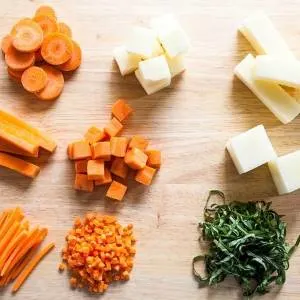 Whether you are a professional chef or a home cook, knowing the different types of food cutting styles can make or break your dish. From dicing to julienning, here are eight different types of cuts that every cook should know.
Whether you are a professional chef or a home cook, knowing the different types of food cutting styles can make or break your dish. From dicing to julienning, here are eight different types of cuts that every cook should know.
Chop
Chopping is a basic cutting technique that is used to cut ingredients into smaller pieces. To chop, hold the ingredient in one hand and use your other hand to hold the knife. Point the knife at the ingredient and then make a downward, rocking motion with the knife while keeping your fingers tucked behind the blade.
Learn more: Types of Kitchen Knives: 11 Varieties For Home Chefs
Let’s be clear: when a recipe says to chop an ingredient, it’s not specifically calling out a size or shape for the pieces to be cut into. To chop is simply to take the fruit or vegetable from its whole form to smaller, more manageable pieces.
Before you start chopping, slicing, or chiffonade-ing, be sure that you’re holding your knife correctly. Here is an awesome tutorial that demonstrates just how to do that. Once your hands are setup for safe and accurate cutting, you’re ready to start chopping.
Slice
Slicing is a basic cutting technique that is used to cut ingredients into thinner pieces. These pieces are often thin on one side and long on the other. For example, think of an orange slice.
To slice an ingredient, you’ll typically just need to make one type of cut. Taking our orange example, you’d hold the orange by one pole (with that hand in “claw” position to keep your fingers safe) and use your other hand to guide the knife through the fruit, creating anywhere from 4-8 slices.
The slices will be thin circles of orange flesh. Technically, this is called an orange “wheel,” and when you cut each wheel in half, they become orange slices.
You might also like What Kitchen Knives Do You Really Need?
Dice
Dicing is a precise cutting technique that is used to chop ingredients into small cubes. Dicing can be a bit more advanced than basic chopping or slicing.
Like the other types of cuts, when you dice, you’ll hold an ingredient in one hand and use your other hand to hold the knife. Point the knife at the ingredient and make a series downward, rocking motions while keeping your fingers in “claw” form, tucked behind the blade.
Depending on the ingredient you’re dicing, the series of steps will vary. For example, dicing an onion requires turning the vegetable a few different ways and making cuts that don’t go all the way through to the root end. Here’s a great video demonstrating basic knife skills and featuring specifically how to dice an onion:
Julienne
Julienning is a precise cutting technique that is used to create thin strips from vegetables or fruits.
To julienne, you’ll need to “square off” your ingredient first. This means that you’ll trim the sides so that the ingredient becomes more square or rectangular. With a carrot, this means cutting off the rounded edges and giving it four flat sides.
Once you have flat sides, you can lay one side down on the cutting board and proceed with careful cuts to create several thin rectangles.
Next, stack those thin rectangles on each other and cut the stack into skinny “matchsticks.” The finished product is a pile of narrow rectangular pieces. Finely juliennned ingredients are perfect for salads or slaws.
Batonnet
Batonnet is a precise cutting technique that is used to create thin, “baton-like” strips from vegetables like carrots or potatoes. The best example of this type of cut are french fries. The batonnet cut is also used for raw vegetable platters – think of carrot and celery sticks, for roasting, or for stir fries.
The batonnet cut is similar to julienne, but the finished pieces are usually about 2 inches long and about a quarter of an inch thick.
Mince
Mincing is a precise cutting technique used to finely chop ingredients into tiny pieces. To mince, you’ll cut the ingredient several times until the pieces are very small.
When mincing something like garlic, you’ll cut the garlic into smaller pieces, then place your free hand palm-down on top of the knife’s blade, rather than on the garlic itself.
This will allow you to guide the rocking motion of the knife’s blade as you continue mincing the garlic into even smaller pieces. This video demonstrates the mincing process:
Brunoise
Brunoise is a precise cutting technique that is used to finely chop vegetables into tiny cubes – think of it as a teeny dice.
To brunoise, begin with a julienne cut. Then cut the julienned strips into tiny cubes. That’s it!
Chiffonade
Chiffonade is a precise cutting technique that is used to cut herbs or lettuce into thin, ribbon-like strips.
To chiffonade, you’ll place your leaves one on top of the other, forming a stack. Next, roll the stack from the top down. It will resemble a small log.
Hold the log with one hand, keeping the fingers curled back like a claw, and carefully cut the log into very thin strips. When the strips unfurl, you’ll have beautiful, long, thin, ribbons of your herb or lettuce.
Learn more about Basic Knife Skills and find more helpful guides in my Kitchen Tips!
